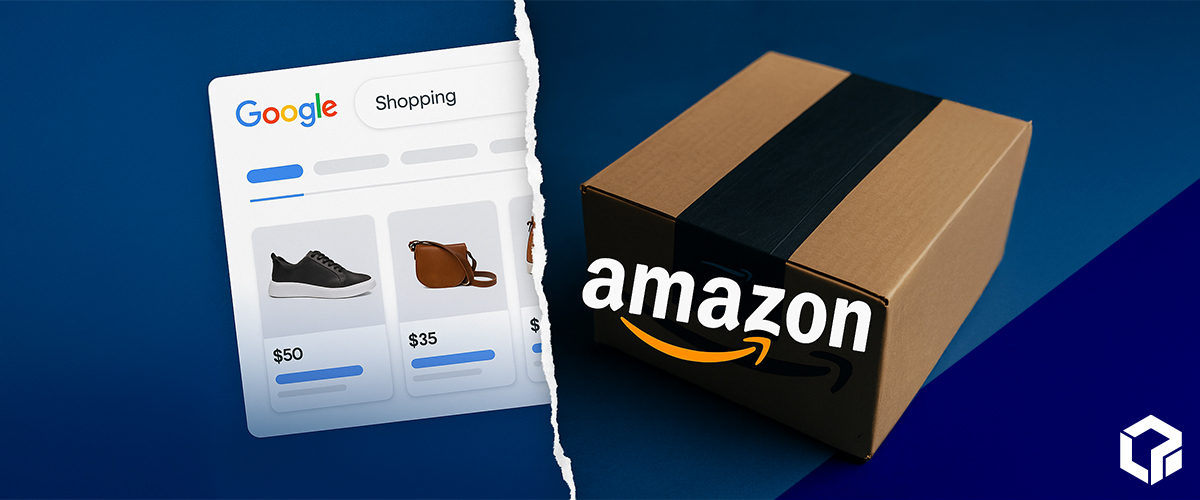The Amazon advertising ecosystem is a dynamic force, projected to surpass $94 billion by 2026. This platform is undeniably central to the ecommerce sphere, commanding a staggering 37.8% of the US ecommerce market and drawing 2.84 billion monthly visits. With over 310 million users globally, including 180 million US-based Prime members, Amazon is not merely a marketplace; it’s a dominant ecommerce ecosystem.
That’s exactly why advertising on Amazon has become a foundational strategy for sellers. Beyond generating immediate sales, Amazon pay-per-click (PPC) campaigns directly influence organic rankings on the platform. For businesses striving for long-term success and visibility, mastering Amazon’s advertising tools is nonnegotiable. Our in-depth guide is indispensable when it comes to understanding how advertising works on this platform and learning how businesses can unlock new opportunities to grow their brand and drive revenue.
The Amazon Advertising Landscape in 2025
Amazon’s advertising ecosystem continues to evolve, introducing advanced tools and features designed to enhance targeting, measurement, and overall campaign efficiency. Staying up-to-date with these innovations is crucial for businesses hoping to remain competitive in this rapidly evolving landscape.
Current Market Dominance
Amazon leads the global ecommerce industry, demonstrating unparalleled reach and influence. With annual revenues exceeding $575 billion, its ability to blend retail, technology, and customer loyalty provides a compelling environment for advertisers. Amazon is not just where people shop; it’s where millions start their product search.
Why does this matter for sellers? Amazon’s market share ensures it is a primary destination for online purchases across virtually every industry. Nearly 38% of US ecommerce transactions happen here, making it a necessity for manufacturers, small businesses, and major brands alike.
This dominance, however, comes with intense competition. Over 9.7 million sellers compete for customer attention. Without an advertising strategy, even the best-designed products risk being buried in a sea of options. Paid efforts are the fastest way to cut through the noise.
Why Amazon Advertising Is Critical for Business Success
There are many reasons why you should advertise your products on Amazon, but one of the most notable is the platform’s emphasis on sales velocity and relevance when determining product rankings. Paid advertising offers an indispensable way to achieve these goals and build organic visibility simultaneously. Here’s how various business types rely on advertising:

- New businesses rely on PPC ads to break into Amazon’s ecosystem. With millions of competitors, building an organic presence takes time and effort, as well as consistent traffic. Ads provide immediate exposure and sales to accelerate this process.
- Established brands depend on PPC to maintain leadership. Amazon’s algorithm rewards fresh and consistent activity. Cutting back on ads can lead to slipping organic rankings, even for well-known brands.
- All sellers, regardless of experience, need advertising because ad clicks lead to sales, which in turn inform Amazon’s ranking engine. Without ads, sellers miss the opportunity to amplify both paid and unpaid visibility.
Amazon Advertising Fundamentals
Understanding the core principles behind Amazon’s advertising system is vital if you want to leverage its full potential. By aligning your advertising strategies with Amazon’s ranking algorithms, you can optimize both visibility and profitability, ensuring sustainable growth in a highly competitive marketplace.
The Unique Amazon Ecosystem
One of the hallmarks of Amazon’s advertising model is its closed-loop ecosystem. Unlike platforms such as Google or Facebook, which direct traffic elsewhere, all Amazon ad clicks stay within its marketplace. This environment fosters higher purchase intent. Shoppers are not there to research or browse casually; they’re ready to buy.
Additionally, Amazon’s A9 algorithm rewards listings that generate high sales and conversion rates. Ad campaigns that secure these metrics push listings up in organic search results, creating a virtuous cycle of increased visibility.
Amazon easily outperforms other platforms in conversion rates. While the average conversion rate for ecommerce websites is around 2% and 4% (depending on industry), Amazon achieves a remarkable 10%. This purchase-ready audience justifies investing in its ad tools for any product-focused business.
How Amazon Ads Differ From Google and Facebook
While Google and Facebook cater to research stages of the buyer’s journey, Amazon users often know exactly what they’re looking for. This distinction creates key differences:

- Sales attribution on Amazon is more transparent. Every ad click can be tied directly to a sale, making the platform ideal for tracking return on investment.
- Inventory matters more. Unlike Google, where limited SKU availability won’t affect performance, Amazon retires ads automatically if inventory runs out. Sellers need robust stock management to sustain campaigns.
- Competition against similar products is intensified. Rather than targeting generic keywords, most Amazon PPC advertisers directly compete against products identical or very similar to their own. Winning bids in this environment requires a nuanced strategy and pricing.
These differences make Amazon a unique platform that rewards precise execution at a fraction of the effort needed to obtain such results elsewhere.
What To Know About the Various Amazon Ad Types
Amazon offers a range of different ad types designed to suit a variety of goals and strategies. Choosing the appropriate ad format is essential for maximizing visibility, driving sales, and optimizing return on investment.
However, with many different types of Amazon ads to choose from, selecting the right mix requires research and testing. It’s essential to understand the features and benefits of each ad type to determine which aligns best with your business goals. By narrowing down your options, you can strategically integrate the most effective formats into your broader Amazon marketing strategy to maximize your chances of success.
Strategic Campaign Planning and Setup
When planning a successful campaign, it is essential to align objectives with specific ad formats to maximize impact. Understanding audience behavior and leveraging data-driven insights will ensure that campaigns resonate effectively with target demographics. This all starts with an effective campaign.
Financial Readiness
Knowing your break-even point is essential, and while a 30% profit margin is preferred, it isn’t a strict threshold for growth. Even brands with tighter margins can benefit from higher ad spend when coupled with increased Average Order Value (AOV) through B2B targeting or factoring in Customer Lifetime Value (CLTV) and Subscribe & Save (S&S) orders are in play. To ensure profitable scaling, sellers must evaluate Cost of Goods Sold (COGS) and Amazon fees together to understand true margins.
Inventory Management
Running out of stock can seriously damage performance on Amazon, as the platform quickly penalizes listings with inventory lapses by dropping organic rankings significantly. Regaining that visibility typically requires increased ad spend, lower ROAS, and even then, there’s no guarantee you’ll recover your previous position. To avoid this costly setback, use tools to calculate stock velocity and anticipate demand spikes before launching campaigns, ensuring your inventory can support your growth efforts.
Setting Goals at Each Stage

Your goals will vary based on how long your campaigns have been running, but they should look something like this for ideal results:
- Short-term (0–3 months) focuses on generating visibility. Successful campaigns here often use relaxed ACoS targets to prioritize impressions.
- Mid-term (3–12 months) aims to generate scalability with profitable returns, typically a ROAS of 3x or more.
- Long-term (12+ months) involves category dominance, such as securing long-term top rankings and planning cross-market expansion.
Keyword Strategy
Amazon PPC has become increasingly competitive, and successful campaigns demand not just keywords, but the right keywords used at the right time. Knowing the basics of keyword bidding through Amazon marketing will help here, but the optimization of your strategy by utilizing recent advancements will ensure you keep pace with competing companies.
Competitor Keyword Analysis
Amazon now offers more robust data tools—such as Product Opportunity Explorer and Category Insights—to help monitor how your products and ads perform relative to the broader category. While you can’t directly reverse-engineer competitor campaigns, these tools allow you to benchmark against top-performing peers and identify keyword trends or gaps in your strategy. This insight can guide data-backed adjustments and help uncover new opportunities to enhance visibility and competitiveness.

Seasonal Keyword Planning
Seasonality plays a significant role in ecommerce sales. Rather than focusing on broad holiday-specific keywords, it’s more effective to increase bids on relevant, high-performing keywords during peak traffic periods. For example, if your catalog includes items like a “flattop grill for dad” or a “beard grooming kit,” these product-specific terms should be prioritized around Father’s Day. Preparing bidding strategies months in advance allows you to capitalize on seasonal surges while staying aligned with your product offerings.
Advanced Match Type Strategies
As you learn the fundamentals of how marketing works on Amazon, you’ll need to explore the nuances of keyword research. Fine-tuning your match type usage is essential for maintaining a balance between effective reach and reduced ad spend wastage. The match types you select for keywords influence how and where your ads appear:
- Exact match keywords give you maximum precision over ad relevance. For example, if you’re targeting “ergonomic office chair,” your ad will only display for that exact phrase, eliminating irrelevant traffic.
- Phrase match expands your reach while maintaining some level of relevance. The phrase “ergonomic office chair” will also trigger ads for “best ergonomic office chair” and “ergonomic office chair for short people.”
- Broad match with negatives enables maximum visibility but requires caution to prevent wasted spend. For instance, broad match keywords like “office chair” might attract irrelevant searches like “computer desks,” unless negative keywords are used.
- ASIN targeting allows sellers to directly advertise on the product pages of competitors. For example, if a rival’s listing has a low review score or lacks certain features, your ad can position your product as the better choice.
Performance Monitoring and Analytics
Tracking the right metrics is essential to understand if you’re truly achieving your goals. Amazon’s enhanced performance monitoring tools in 2025 provide deeper insights than ever before.
Efficiency Metrics
- ACoS (advertising cost of sale): reveals how much of your revenue is reinvested into advertising.
- TACoS (total advertising cost of sale): integrates organic sales into the equation, helping assess the full impact of your ads.
- Conversion rate: tracks how effectively clicks turn into sales. A consistent upward trend here indicates solid campaign performance.
Growth Metrics

- Impression share: measures visibility against your competition. If your product isn’t being seen, it isn’t being purchased.
- Share of voice (SoV): tracks how your brand compares to others in your category in terms of visibility and engagement.
- Customer Lifetime Value (CLTV): focuses on long-term profitability by considering repeat purchases and overall customer retention.
Advanced Reporting Features
Amazon continues to expand its suite of reporting tools to offer deeper, more actionable insights. The Search Query Performance report provides visibility into how customers are discovering your products, helping inform keyword strategy and content optimization. Additionally, Amazon Marketing Cloud (AMC) now supports audience integration for Sponsored Product campaigns, enabling more granular targeting. Advertisers can also leverage Amazon Business Placement modifiers to tailor bids specifically for Amazon Business customers, optimizing reach within the B2B segment.
Campaign Troubleshooting and Optimization
Even with careful planning and execution, challenges will arise during your campaigns. Worst case is your Amazon ads aren’t showing at all. Knowing how to diagnose and resolve these is critical to maintaining profitability and growth.
Low Click-Through Rates (CTR)
If your CTR is below category benchmarks, ask yourself:
- Are your product images optimized for mobile viewing?
- Does your title highlight a clear benefit or compelling feature?
If the answer is no, consider A/B testing different main images or refining ad copy to address specific customer pain points.
High ACoS With Minimal Conversions

This typically signals poor relevance or pricing issues. Consider:
- Are you priced competitively within your category?
- Do you have sufficient positive reviews to establish trust?
Building up social proof through review acquisition campaigns and refining your targeting will help immensely here.
Inventory Challenges
Running out of stock can devastate your ad performance and rankings. To avoid this:
- Use seasonal forecasting and automate reorder alerts to prepare for periods of high demand.
- Establish safety calculations that consider your ad velocity when managing inventory.
Industry-Specific Strategies
Every industry has unique challenges and opportunities when advertising on Amazon. The strategies that work for high-competition product categories, such as electronics, differ greatly from those tailored to emerging niches like sustainable products or B2B supplies. Understanding these nuances is pivotal to optimizing your campaigns effectively.
High-Competition Categories
Successfully navigating high-competition categories requires a data-driven approach combined with robust ad spend management. Leveraging Impression share metrics and information from the Search Query Performance report, along with detailed competitor analysis can help identify opportunities that maximize your return on investment while maintaining visibility.
Electronics and Technology
This category is one of the most crowded on Amazon, with thousands of listings for similar items. The following strategies will help you stand out:
- Focus on technical specifications and use cases. Consumers shopping for gadgets often compare features like battery life, compatibility, and unique functionalities. Highlight these attributes in your product titles and descriptions.
- Leverage lifestyle imagery to showcase the product in real-world settings. For instance, advertise a gaming headset by showing it being used during an intense gaming session, with clear emphasis on comfort and sound quality.
Health and Personal Care
Products in this category demand transparency and trust. Consumers want to know how these products benefit them and whether they are safe.
- Ingredient differentiation is crucial for success. Use Enhanced Brand Content (A+ Content) to break down the natural or organic qualities of your products.
- Generate trust through reviews and certifications. Products like supplements or skincare items sell better when they highlight third-party testing or FDA compliance.
Home and Kitchen
This category benefits massively from seasonality and context-based advertising.
- Optimize for holidays and seasons. Cooking appliances should receive heavy advertising during the holiday season, while outdoor kitchen equipment might do well in the spring and summer when consumers prepare for barbecues.
- Use sponsored carousels effectively by grouping complementary products, such as pans, knives, and cutting boards, into a cohesive campaign.
Emerging Opportunity Categories
Emerging opportunity categories are those that show rapid growth potential due to evolving consumer behaviors or trends. Staying ahead in these categories requires agility, data-driven strategies, and a focus on innovative product offerings.
Sustainable Products
Sustainability is no longer a niche concept; it’s mainstream. Many consumers seek eco-friendly options that make them feel good about their purchasing decisions.
- Highlight certifications, such as USDA Organic, Fair Trade, or Carbon Neutral, when applicable. These badges hold significant sway with sustainability-focused audiences.
- Share your story. Customers who buy sustainable products appreciate knowing the “why” behind your product. If your supply chain reduces emissions or your company plants trees for every product sold, share that through video ads or Sponsored Brands content.
Smart Home Technology
The smart home tech industry is growing rapidly, fueled by advancements in automation and connectivity.
- Feature integration compatibility in your ads. For example, an ad for a smart thermostat could promote its ability to sync with Alexa or Google Home.
- Educational content works wonders. Shoppers may need help understanding how smart home tech benefits their lifestyles. Using video campaigns to explain installation or use simplifies their decision-making process.
Pet Products
Amazon customers treat their pets like family, meaning purchases in this category are often driven by emotion.
- Focus on safety and emotional benefits. Highlight features such as nontoxic materials for chew toys or ergonomic designs for pet beds to win over cautious pet parents.
- Bundle complementary items to increase cart value. Advertising a grooming kit that includes clippers, combs, and nail grinders creates a seamless shopping experience.
B2B Product Strategies
Amazon Business has opened up a different avenue of opportunity for sellers targeting corporate and industrial clients. Selling to businesses requires a shift in messaging to emphasize bulk purchases, efficiency, and ROI.
Professional Tools
B2B buyers prioritize durability and reliability, so emphasize this with your marketing efforts.
- Focus on total cost of ownership (TCO) by showcasing metrics like product lifespan or maintenance costs to illustrate long-term savings.
- Advertise business-friendly features. Highlight benefits such as extended warranties or volume-based discounting to appeal to institutional buyers.
Industrial Supplies

Selling supplies like machinery components, safety gear, and raw materials typically requires a focus on operational efficiency.
- Use data sheets and spec breakdowns. Industrial buyers expect detailed dimensions, material types, and other specifications in your product descriptions.
- Offer repeat ordering convenience through subscription options or automatic reorders. This encourages customer retention and loyalty.
Office Products
Office buyers are typically looking for cost efficiency and time-saving solutions, so highlight those accordingly.
- Position products as productivity tools. For example, promote a noise-canceling headset to improve work-from-home focus or an ergonomic chair to reduce workplace injuries.
- Bundle deals are a must. Selling items like printer paper and cartridges together boosts value and makes bulk orders more enticing.
Professional Management vs. DIY
Investing in Amazon advertising can feel daunting for businesses managing multiple marketplaces and campaigns. While smaller brands or startups often opt for DIY strategies, larger, more complex campaigns benefit immensely from professional management. Still, both options are equally viable for companies of any size.
When to Consider Professional Management
If your campaigns are exceeding $5,000–$10,000 in monthly ad spend or involve managing 15+ products across different categories, it’s time to consult an Amazon Ads expert. Additionally, sellers launching international campaigns or targeting niche audiences often struggle to handle the complexities without expert guidance. Here’s a look at why professional agencies excel.
Access to Exclusive Tools and Features
Certified Amazon Advanced Partners often gain early access to beta features and platform updates, giving their clients a competitive edge. Because of this access, they also have more detailed insight into how they work.

ROI Improvements
Many businesses have found that professional management can boost ROAS by 200% to 400% within months. This stems from their ability to conduct granular bid optimizations, execute advanced targeting strategies, and manage performance anomalies in real time.
Time Savings
Amazon PPC requires hours of monitoring and analysis each week. For business owners, outsourcing to a professional frees up time to focus on scaling other areas of their operations.
Selecting the Right Amazon Advertising Partner
Choosing the right Amazon advertising management company for your needs requires careful consideration. Look for partners with:
- a proven track record in your specific industry
- certifications like Amazon Advanced Partner status
- transparent reporting and actionable insights in their communication
Avoid agencies that offer “guaranteed rankings” or refuse to customize approaches for your unique goals. Cookie-cutter solutions lead to missed opportunities.
The Future of Amazon Advertising
The future of Amazon advertising is marked by technological innovation, evolving shopper behavior, and new market opportunities. Businesses need to adapt to these trends to stay ahead.
Technology Trends
As we’ve indicated earlier, AI is set to play a bigger role in ecommerce, managing tasks like bid adjustments, audience segmentation, and predictive analytics. However, agencies that rely too heavily on AI tend to miss opportunities that experienced human oversight is needed to identify.
Voice commerce is also on the rise, with Alexa integration making it essential for sellers to optimize for conversational queries. Picture a shopper asking, “Alexa, recommend budget-friendly coffee makers,” and your brand appearing as the top recommendation.
Augmented reality (AR) is transforming the shopping experience as well. AR allows customers to “try on” products like sunglasses or visualize furniture in their space before making a purchase.
Market Evolution
Something else worth considering is learning how to launch an Amazon ad campaign in another country. The reason for this is that many international markets, such as Ireland and Southeast Asia, are emerging as valuable opportunities for ecommerce expansion. Sellers who invest early in localized advertising strategies will secure a strong competitive edge.
Additionally, privacy-centric advertising is gaining focus, with platforms like Amazon transitioning to cookieless tracking methods. Leveraging first-party data and server-side tracking will be crucial for compliance and staying ahead.
Getting Started: Step-by-Step Implementation
Stepping into Amazon advertising need not be overwhelming. By breaking down the timeline into manageable phases, businesses can launch and refine their campaigns strategically.

Phase 1: Foundation Setup (Weeks 1–2)
- Audit your existing ad portfolio to assess performance and establish baseline metrics (CTR, CPC, ROAS).
- Conduct competitive research to identify high-potential keywords that align with product categories and customer intent.
- Identify industry trends and competitor gaps to capitalize on.
- Strategically allocate your budget, prioritizing new launches and top-performing products.
Phase 2: Campaign Launch (Weeks 3–4)
- Use Amazon’s tools to organize campaigns by brand, product category, and targeting type (automatic, manual, keyword-based).
- Launch test campaigns to gather data on performance, audience behavior, and keyword effectiveness.
- Focus on collecting insights, not immediate profitability.
- Monitor metrics daily to catch and fix any issues quickly.
Phase 3: Optimization and Scaling (Weeks 5–8)
- Analyze KPIs like CTR, conversion rates, and ACOS to identify underperforming campaigns.
- Reallocate budgets to high-performing campaigns to maximize ROI.
- Expand keyword targeting with high-converting terms from the test phase.
- Adjust bids and segment audiences to refine strategies.
- Introduce new ad formats like Sponsored Display and Sponsored Brands to diversify campaigns.
Phase 4: Advanced Strategy (Weeks 9–12)
- Develop region-specific campaigns for international markets using localized keywords and cultural insights.
- Utilize video ads and shoppable posts to engage shoppers dynamically.
- Leverage Amazon’s audience insights for targeted remarketing campaigns.
- Build a data-driven, scalable strategy for long-term growth and global reach.
Wrapping Things Up
Mastering Amazon advertising is a staged process that evolves with your business’s growth. By focusing on strategic planning, leveraging advanced ad types, and consistently optimizing campaigns, companies can achieve not just visibility but sustainable revenue growth. Now that you better understand how marketing works on Amazon, if you’re ready to break into advertising on the platform, don’t delay—start today.





